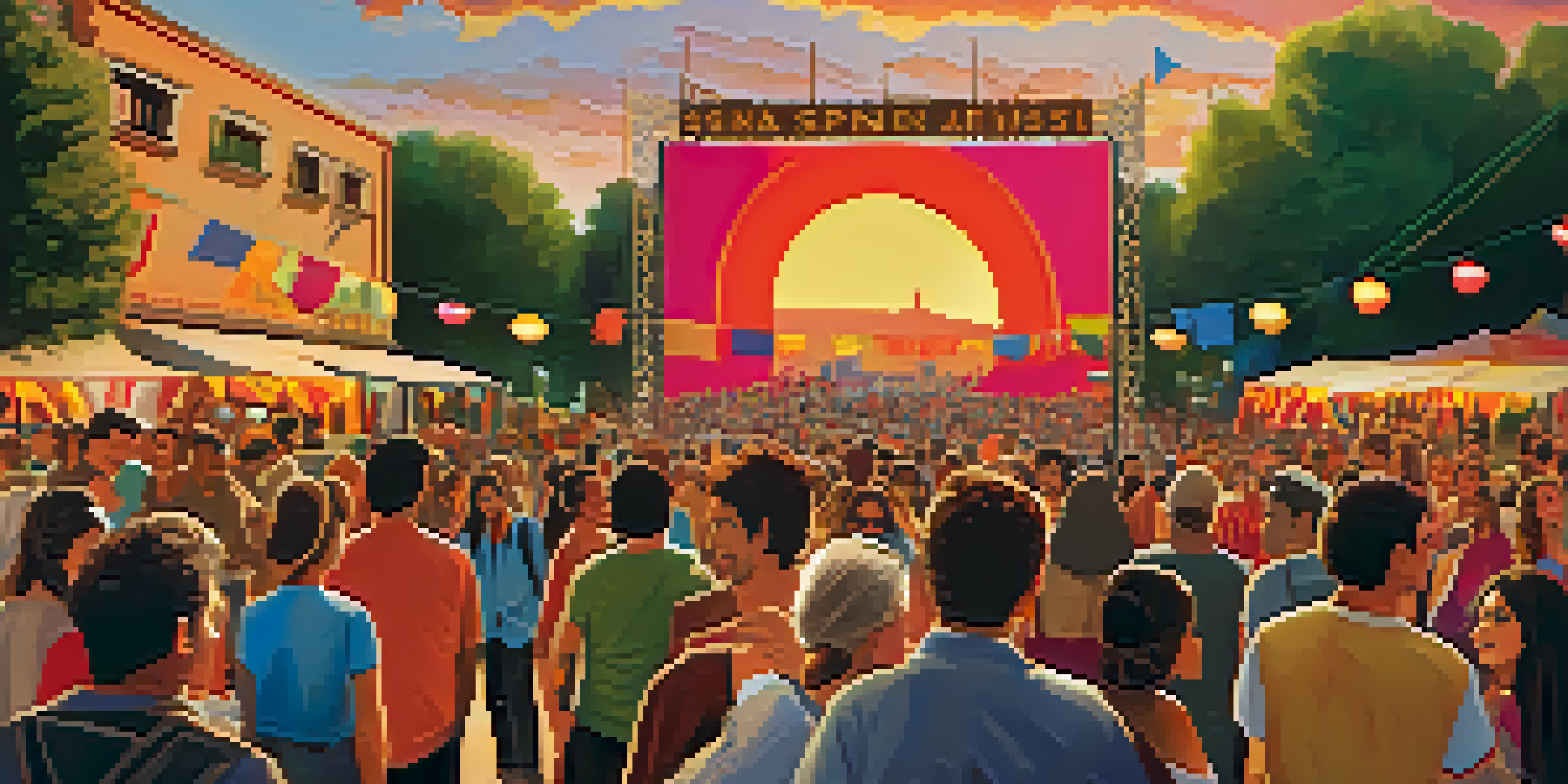Contemporary Spanish Cinema: A Cultural Reflection

The Evolution of Spanish Cinema in the Modern Era
Contemporary Spanish cinema has undergone significant transformations since the late 20th century. This evolution reflects Spain's sociopolitical changes and a growing global influence. Filmmakers are now experimenting with diverse genres and narratives, breaking away from traditional storytelling.
Cinema is a mirror by which we often see ourselves.
The end of Franco's regime in the 1970s paved the way for filmmakers to explore previously taboo topics. Directors like Pedro Almodóvar emerged, infusing their works with vibrant colors and complex characters. This shift has allowed for a more authentic representation of Spanish life and culture.
Today, Spanish cinema is recognized worldwide, with films such as 'Pan's Labyrinth' and 'The Sea Inside' showcasing its depth. The blend of local stories with universal themes resonates with audiences, making contemporary Spanish films both relatable and thought-provoking.
Key Themes in Contemporary Spanish Cinema
Current Spanish films often tackle themes such as identity, memory, and societal change. These themes are reflective of Spain's rich history and the ongoing struggles of its people. For instance, the exploration of the Spanish Civil War and its lasting impact can be seen in many recent films.

Directors frequently use personal stories to address broader social issues, creating a deep connection with viewers. Films like 'The Invisible Man' highlight the challenges of marginalized communities, while also showcasing resilience and hope. This narrative technique helps to humanize complex societal issues.
Spanish Cinema Embraces Diversity
Contemporary Spanish films explore a range of themes, including identity and cultural representation, reflecting Spain's rich history and societal changes.
Moreover, contemporary cinema often incorporates elements of magical realism, blending fantasy with reality. This approach not only captivates the audience but also serves as a metaphor for the emotional landscape of Spain today, making the films feel both imaginative and grounded.
Influential Directors Shaping Contemporary Spanish Cinema
Several directors are at the forefront of contemporary Spanish cinema, each bringing their unique voice and perspective. Pedro Almodóvar, known for his vibrant storytelling and complex characters, has significantly impacted the global perception of Spanish films. His works often explore themes of sexuality, family, and identity.
Film is a powerful medium for exploring identity and culture.
Another important figure is Alejandro Amenábar, who gained international acclaim with films like 'The Others' and 'Open Your Eyes.' His ability to blend genres and create suspenseful narratives has resonated with audiences worldwide. Amenábar's work often delves into philosophical questions, inviting viewers to reflect on deeper meanings.
Additionally, directors like Isabel Coixet and Juan Antonio Bayona have made substantial contributions to the industry. Coixet's films often center around themes of loneliness and connection, while Bayona's works, such as 'The Orphanage,' combine emotional depth with thrilling storytelling. Together, these filmmakers are redefining what Spanish cinema can achieve.
The Role of Festivals in Promoting Spanish Cinema
Film festivals play a crucial role in showcasing contemporary Spanish cinema, providing a platform for filmmakers to gain recognition. The San Sebastián International Film Festival, for instance, is a prominent event that celebrates Spanish and international cinema alike. It not only highlights new talent but also encourages discussions about pressing cultural issues.
Another key festival is the Málaga Film Festival, which focuses on Spanish-language films and promotes emerging filmmakers. This festival has become a springboard for many successful careers, helping new voices find their place in the industry. It emphasizes the importance of regional stories and cultural diversity.
Festivals Boost Spanish Film Visibility
Film festivals like San Sebastián and Málaga play a crucial role in promoting Spanish cinema, providing platforms for new talent and fostering international collaborations.
These festivals also foster international collaborations, allowing Spanish films to reach a broader audience. By screening at prestigious events, filmmakers can engage with global viewers and critics, amplifying their impact. This exposure is vital for the continued growth and recognition of contemporary Spanish cinema.
The Impact of Streaming Services on Spanish Films
The rise of streaming services has dramatically altered the landscape of contemporary Spanish cinema. Platforms like Netflix and Amazon Prime are now investing in Spanish productions, leading to a surge in visibility for local filmmakers. This shift offers a unique opportunity for Spanish films to reach international audiences without the constraints of traditional distribution.
Streaming services also encourage diversity in storytelling by financing a variety of genres and voices. This has resulted in a rich array of content, from riveting dramas to lighthearted comedies. The increased funding allows filmmakers to push creative boundaries and experiment with new ideas.
Moreover, accessibility has improved, with viewers able to watch films from the comfort of their homes. This convenience has sparked interest in Spanish cinema among audiences who may not have explored it otherwise. As a result, contemporary Spanish films are gaining a foothold in global pop culture.
Cultural Identity and Representation in Modern Spanish Cinema
Contemporary Spanish cinema frequently grapples with themes of cultural identity and representation. The country's diverse regions, each with their own languages and traditions, are often reflected in films. This rich tapestry of cultures allows filmmakers to tell unique stories that resonate with both local and international audiences.
Films like 'Ocho Apellidos Vascos' showcase regional identities while also addressing stereotypes in a humorous way. This approach not only entertains but also educates viewers about Spain's complex cultural landscape. It encourages a dialogue about identity and belonging in an increasingly globalized world.
Streaming Services Expand Reach
The rise of streaming platforms has increased the visibility of Spanish films globally, allowing filmmakers to experiment with diverse narratives and reach wider audiences.
As conversations about representation continue to evolve, filmmakers are becoming more mindful of inclusivity. This shift is vital for ensuring that diverse voices are heard and depicted authentically. By embracing this responsibility, contemporary Spanish cinema can authentically reflect the society it represents.
The Future of Contemporary Spanish Cinema
Looking ahead, the future of contemporary Spanish cinema appears bright, with emerging filmmakers eager to explore new narratives. The influx of young talent brings fresh perspectives and innovative storytelling techniques. This generation is poised to push boundaries and redefine what Spanish cinema can achieve.
As technology continues to evolve, filmmakers are also adapting to new formats and platforms. The rise of virtual reality and interactive storytelling presents exciting opportunities for creative expression. This willingness to experiment will likely attract a younger audience, ensuring the relevance of Spanish cinema.

Furthermore, as global interest in Spanish culture grows, opportunities for international collaborations are increasing. Filmmakers can draw inspiration from diverse sources while still honoring their roots. This blend of influences will undoubtedly shape the next chapter of contemporary Spanish cinema, making it a vibrant part of the global film landscape.